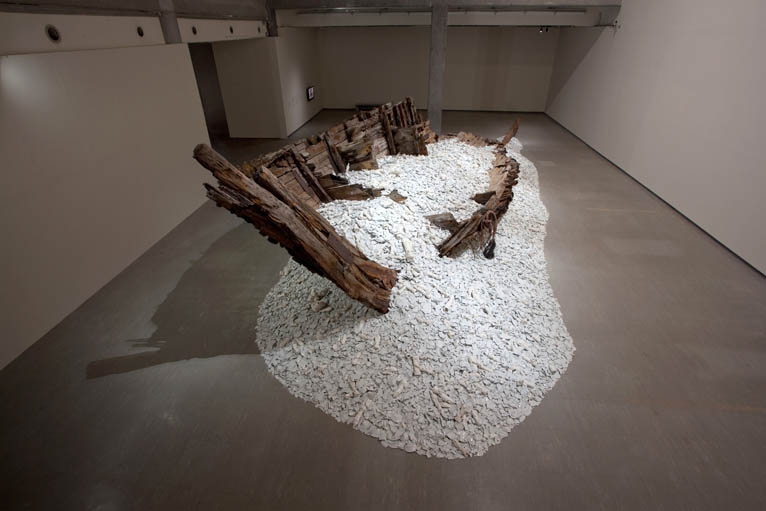CAI GUO-QIANG: HANGING OUT IN THE MUSEUM
| February 1, 2010 | Post In LEAP 1

Cai Guo-Qiang’s retrospective “I Want to Believe” opened with a gala dinner in the Solomon R. Guggenheim Museum rotunda two years ago this month. In the speechmaking that accompanied those bubbly festivities, Thomas Krens, then-director of the Guggenheim, compared Cai to Beuys (another world-class artist brought to true fame by a show in Wright’s hallowed hall) and Cai invoked his own visit to the museum with David Hammons, who told him it was his destiny to show there. [Full disclosure: I contributed to the “I Want to Believe” catalogue as compiler of an anthology of Cai-related texts.] Guests made numerous mentions of China’s rising stature in eager anticipation of the Olympic Games. But one situational irony lost on much of the audience was that the woman translating for Cai (the artist refuses to speak English even after thirteen years in New York and more than twenty on the international exhibition circuit) was the daughter of the man who would be elected Taiwan’s president just two weeks later.
The question of Cai and Taiwan is a worthy one: as a nexus of Fujianese folk culture and Japanese, American and mainland colonial histories, it may in fact be the ideal context for Cai, who draws in more or less equal parts on these four traditions. In the give-and-take surrounding what the press release calls the “grand-scale retrospective personal exhibition of contemporary international artist Cai Guo-Qiang” titled “Hanging Out at the Museum”– an accurate, if somewhat awkward, translation of a willfully colloquial Chinese title– as many interesting issues about the cultural position of the renegade province come to light as new revelations about Cai’s practice. In Taiwan he is regarded as a true-blooded hometown hero, a markedly different dynamic from Japan (where he was always seen as an exotic curiosity), the United States (a powerful interloper from a rising power), or mainland China (an opportunistic returnee looking for both government approbation and Western accolades).

For many reasons probably not all that interesting, this exhibition was not demarcated as the last stop on the “I Want to Believe” tour, which went to Beijing and Bilbao after its New York run. The 35-work installation in Taipei did share a number of major pieces with the earlier exhibition:―the lobby full of cars (Inopportune: Stage One, 2004/2009), the oft-criticized installations of tigers and wolves, the Rent Collection Courtyard in progress, the unearthed Iwaki ship-hull, and a slew of early gunpowder paintings and explosion-event documentation among them. But some of the key pieces of the earlier show,―notably the provocative installation Borrowing Your Enemy’s Arrows (1998),―had been scrapped, where others like the iconic “whirlpool piece” Cultural Melting Bath (1997/2009) were added. (Little matter that this piece, originally mounted at the beginning of Cai’s New York sojourn at the Queens Museum with a distinctly mixed-race cast of bathers, loses just a little something when its participants are all young Taiwanese.) Tweaks aside, the impression of a virtuosic artist with little regard for medium and a penchant for scale remained unchanged.
For viewers already intimately acquainted with Cai’s practice, perhaps the way in which Cai turns introspective in front of a Chinese audience is more interesting. For the Beijing installation of “I Want to Believe,” he converted the National Art Museum of China’s signature curved gallery into a museum of the self, displaying a sprawling timeline illustrated with his personal and career highlights. That impulse remained, this time augmented with Eslite’s (Cai’s Taiwanese gallery and the exhibition’s organizer and funder) impressive collection of news clippings about his various projects, all from a distinctly Taiwanese perspective. Aside from the extensive coverage devoted to works like his contribution to the 2000 Taipei Biennial or his 1998 project to explode the National Fine Arts Museum in Taichung, one sees in these intricately catalogued hard-copies a Taiwanese slant on the artist’s collaborations with local celebrities or his failed 2003 attempt to light up Central Park. In Beijing, the timeline seemed like so much Olympic megalomania, but here Cai’s time became a sort of public time, grafted onto the larger and ever-changing contexts first of the Lee Teng-hui and then the Chen Shui-bian years, documenting less the artist’s emergence and rising prominence than the increasingly cozy relationships among Taiwan, the People’s Republic and the United States.

The exhibition included three new pieces, two of which are extended gunpowder drawings of local interest (one on the Taroko Gorge and another, Night and Day, created before a live audience in the run-up to the exhibition, capturing thirteen poses of a dancer from the Cloud Gate Dance Theatre of Taiwan with which Cai has long collaborated.) Perhaps most problematic was the third, Strait (2009), a massive hunk of granite mapping the negative space between the Taiwanese west and Fujianese east coasts. The work was meant to evoke the ballast used to keep shipping vessels on course but instead bizarrely evoked a work by his arch-contender for Chinesecontemporary laurels, Ai Weiwei. With a rippled surface meant to evoke the water its shape depicted, the stone’s concept struggled to justify its expense.
The day after the opening, a visit to Eslite’s downtown flagship bookstore, situated in an approximate triangle with national symbols including the Sun Yat-sen memorial and the Taipei 101 tower, showed the whole store facade given over to the exhibition. The tellers in every department rewarded nominal purchases with Cai tickets and lapel pins. Slightly bigger buys got a 2010 calendar made from matches. At least in Taipei, Cai is an idol in no danger of twilight. Philip Tinari


